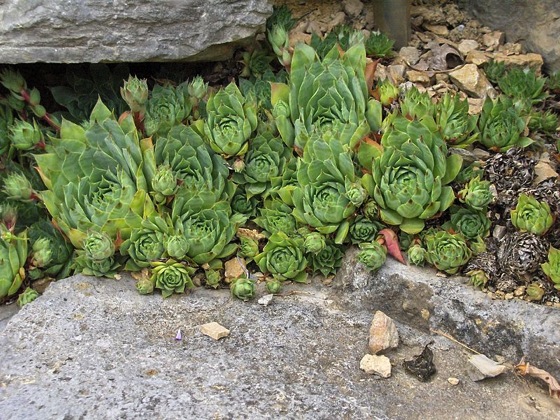Sempervivum
I remember my grandmother always have pots of sempervivum growing both inside and outside the house. She would have called then “hen and chicks” of course, the common name we all used back in Ohio. This was long before I was taking any interest in the Latin names of plants. (LAUGH)
One of the common names, ‘Hen and chicks” comes from the nature of the sempervivum to put off little sprouts along its base which gather like chicks around a mother hen. These also make the plant easy to propagate, as the “chicks” can be carefully pulled off and planted elsewhere. These hardy plants are great for any beginning gardener and those who just want something that is always showing some life throughout the year. They also come in a large number of varieties, so there is something here for nearly everyone.
- Sempervivum /sɛmpəˈvaɪvəm/,[1] is a genus of about 40 species of flowering plants in the Crassulaceae family, known as houseleeks. Other common names include live forever and hen and chicks. They are succulent perennials forming mats composed of tufted leaves in rosettes. In favourable conditions they spread rapidly via offsets, and several species are valued in cultivation as groundcover for dry, sunny spots.[2]
The name Sempervivum has its origin in the Latin semper (“always”) and vivus (“living”), because this perennial plant keeps its leaves in winter and is very resistant to difficult conditions of growth.[3] The common name houseleek is believed to stem from the traditional practice of growing plants on the roofs of houses to ward off lightning strikes.[3] The plant is not closely related to the true leek, which belongs to the onion family.
Other common names reflect the plant’s ancient association with Thor, the Norse god of thunder, and the Roman Jupiter. Hence names such as “Jupiter’s beard” and the German Donnersbart (“thunder beard”).[3]
- — Wikipedia
More Sempervivum books, art, plants and seed at Amazon.com
Previously in the Interesting Plant series:
- Primula auricula
- Feathery Cassia (Senna auricula)
- Red Stick Dogwood (Cornus alba ‘Sibirica’)
- Japanese Maple (Acer palmatum)
- Kousa Dogwood (Cornus kousa)
- Giant Chalk Dudleya (Dudleya brittonii)
- Sunrose (Helianthemum nummularium)
- Australian/New Zealand Tea Tree (Leptospermum scoparium)
- Brugmansia Sanguinea
- Calico Monkeyflower (Mimulus pictus)
- Colocasia Esculenta
- Acer palmatum ‘Sango-kaku’ (Coral Bark Japanese Maple)
- Linderniaceae (formerly Torenia) Kuaui Deep Blue
- Passiflora (Passion flower)
- Firewheel Tree (Stenocarpus sinuatus)
- Anemone
- Allium Cowanii
- Symphyotrichum oblongifolius (Purple Aster)
- Hemerocallis ‘Derrick Cane’ (Daylily)
- Agastache ‘Aztec Rose’
- Rudbeckia hirta Moreno
- Kalanchoe Tomentosa
- Albuca namaquensis
- Hosta ‘Remember Me’
- Dahlia ‘Clair de Lune’
- Lovely silver-tinged fern on campus of Oberlin College, Ohio
- Tricolor Beech (Fagus sylvatica Purpurea Tricolor)
- Climbing Hydrangea (Hydrangea anomala petiolaris)
- Eremurus ‘Lemon Meringue’
- Lupine “Sunrise” (Lupinus hartwegii)
- Chinese Fringe Flower (Loropetalum chinense)
- Streptocarpus ‘Harlequin Blue’
- Nigella damascena (love-in-a-mist, ragged lady)
- Epiphyllum (Orchid Cactus)
- Sempervivum ‘Westerlin’
- Gladiolus ‘Kings Lynn’
- Hosta sieboldiana ‘Dorothy Benedict’
- Begonia “Escargot”
- Asparagus Pea (Psophocarpus tetragonolobus)
- Rosa banksiae (Lady Banks’ Rose)
- Primula ‘Victoriana Silver Laced Black’
- Oxalis versicolor
- Poached Egg Plant (Limnanthes douglasii)
- Parisian Carrots
- Fritillaria imperialis Rubra Maxima
- Clematis “Fascination”
- Swiss Chard “Bright Lights”
- Georgia Rattlesnake Melon
- Dianthus Barbathus “Green Ball” or “Green Trick”
- Coleus “Religious Radish”
- Black Forest Calla Lily
- Black Bamboo
Interesting Plant is a series from A Gardener’s Notebook blog and podcast that highlights the most interesting plants I find in my Internet and real-world travels — Douglas



